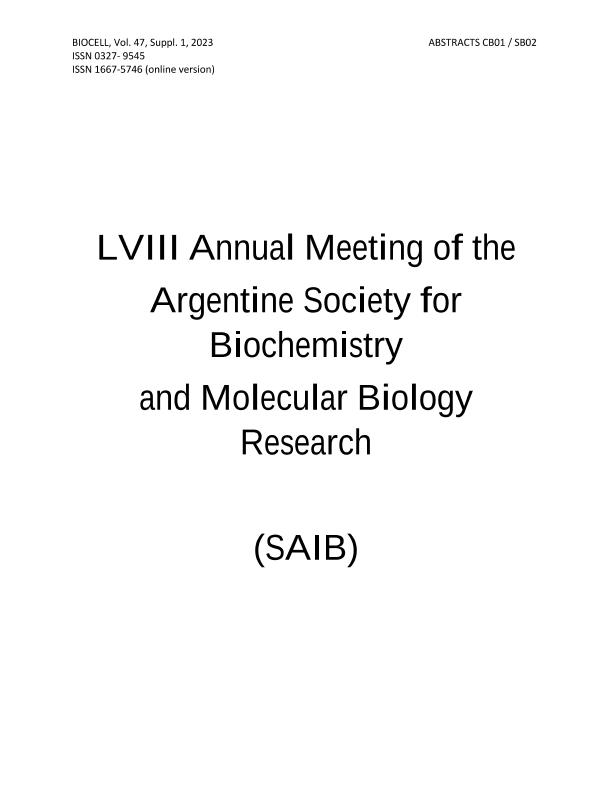Evento
Characterization and biological action of polyethylene glycol-coated magnetite nanoparticles in a cellular model of viral oncogenesis
Principe, Gabriel ; Lezcano, Virginia Alicia
; Lezcano, Virginia Alicia ; Tiburzi, Silvina Mabel
; Tiburzi, Silvina Mabel ; Miravalles, Alicia Beatriz; Montiel Schneider, María Gabriela
; Miravalles, Alicia Beatriz; Montiel Schneider, María Gabriela ; Lassalle, Verónica Leticia
; Lassalle, Verónica Leticia ; González Pardo, María Verónica
; González Pardo, María Verónica
 ; Lezcano, Virginia Alicia
; Lezcano, Virginia Alicia ; Tiburzi, Silvina Mabel
; Tiburzi, Silvina Mabel ; Miravalles, Alicia Beatriz; Montiel Schneider, María Gabriela
; Miravalles, Alicia Beatriz; Montiel Schneider, María Gabriela ; Lassalle, Verónica Leticia
; Lassalle, Verónica Leticia ; González Pardo, María Verónica
; González Pardo, María Verónica
Colaboradores:
Ceccarelli, Eduardo Augusto

Tipo del evento:
Congreso
Nombre del evento:
LVIII Annual Meeting of the Argentine Society for Biochemistry and Molecular Biology Research (SAIB)
Fecha del evento:
08/11/2022
Institución Organizadora:
Sociedad Argentina de Investigaciones en Bioquímica y Biología Molecular;
Título de la revista:
Biocell
Editorial:
Tech Science Press
e-ISSN:
1667-5746
Idioma:
Inglés
Clasificación temática:
Resumen
Magnetic nanotheranostics represent promising alternatives to the traditional diagnostic and treatment procedures available for different pathologies. The goal of this work was to analyze the biological action of polyethylene glycol-coated iron oxide nanoparticles (MAG.PEG) to generate a non-toxic carrier to optimize the delivery of drugs for Kaposi?s sarcoma treatment. The MAG.PEG were synthesized by the hydrothermal method displaying a hydrodynamic diameter of 204 nm and a zeta potential of -22.1 mV. Firstly, MAG.PEG effects on cytotoxicity and cell viability were evaluated on endothelial cells expressing vGPCR, which prompts Kaposi?s sarcoma. By Trypan blue technique, we found that the incubation of these cells neither with MAG nor MAG.PEG (1-150 μg/ml) provoked significant changes in the number of living cells. In addition, cell viability analyzes (MTS and neutral red) revealed that a significant increase in metabolic and lysosomal activity was detected at higher concentrations of MAG or MAG.PEG (100-150 μg/ml) after 48 h of incubation. Secondly, the localization and accumulation of MAG.PEG (1-150 μg/ml) towards the cells was observed directly under a phase contrast microscope. In addition, MAG.PEG assembled within or nearby the cells and cell morphology remained unchanged regardless of the nanoparticles concentration. Furthermore, the presence of vesicles containing MAG.PEG inside vGPCR cells was confirmed by transmission electron microscopy. Thirdly, the iron content quantified by Prussian blue staining showed that the degree of accumulation of MAG.PEG depends on the concentration used. Finally, to steer the MAG.PEG to certain localization in the cell culture, a magnetic field generated by a moderated power magnet was used. The results indicated that the magnetic stimuli induced MAG.PEG accumulation in the zone where the magnet was placed. In conclusion, concentrations between 1 and 50 μg/ml of MAG.PEG would be suitable as drug carriers in this cellular model since no alterations in cell proliferation and viability were observed under the tested conditions. In addition, targeting MAG.PEG to a tumor with a magnet would avoid adverse effects on normal tissues.
Palabras clave:
NANOTECHNOLOGY
,
DRUG CARRIER
,
PEGYLATION
,
Fe3O4
Archivos asociados
Licencia
Identificadores
Colecciones
Eventos(INBIOSUR)
Eventos de INSTITUTO DE CIENCIAS BIOLOGICAS Y BIOMEDICAS DEL SUR
Eventos de INSTITUTO DE CIENCIAS BIOLOGICAS Y BIOMEDICAS DEL SUR
Citación
Characterization and biological action of polyethylene glycol-coated magnetite nanoparticles in a cellular model of viral oncogenesis; LVIII Annual Meeting of the Argentine Society for Biochemistry and Molecular Biology Research (SAIB); Mendoza; Argentina; 2022; 1-2
Compartir



